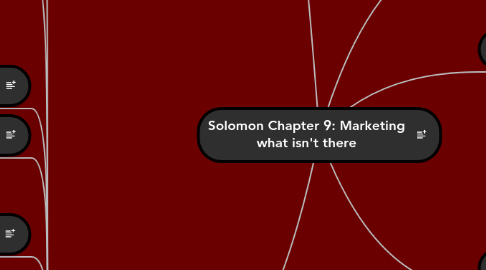
1. Characteristics
1.1. Intangible
1.2. Perishable
1.2.1. Capacity Management
1.3. Inseparability
1.3.1. Service Encounter
1.3.1.1. Dimensions
1.3.1.1.1. Social Dimension
1.3.1.1.2. Physical Dimension
1.3.1.2. The service is only as good as the poorest employee
1.3.2. Disintermediation
1.4. Variability
1.4.1. TQM
2. Service
2.1. Classification
2.1.1. Performed on
2.1.1.1. Consumer
2.1.1.2. Something Consumer owns
2.1.2. Nature of service
2.1.2.1. Tangible
2.1.2.2. Intangible
2.2. Service Continuum p.331
2.2.1. Goods-dominated Products
2.2.2. Equipment- or facility-based services
2.2.2.1. Facility-driven services
2.2.2.1.1. Operational Factors
2.2.2.1.2. Locational Factors
2.2.2.1.3. Environmental Factors
2.2.3. People-based Services
2.3. Core Service
2.3.1. Augmented Service
2.4. Disservice
2.5. Marketing a Service
2.5.1. Service Qualities
2.5.2. Experience Qualities
2.5.3. Credence Qualities
2.6. Providing Service Quality
2.6.1. SERVQUAL
2.6.1.1. Dimensions
2.6.1.1.1. Tangibles
2.6.1.1.2. Empathy
2.6.1.1.3. Reliability
2.6.1.1.4. Responsiveness
2.6.1.1.5. Assurance
2.6.1.2. Can be used in Gap Analysis
2.6.1.2.1. Gaps between
2.6.2. Critical Incident Technique
2.6.2.1. Quick Action
2.7. Services are becoming more important
2.7.1. Important Trends
2.7.1.1. Changing Demographics
2.7.1.2. Globalization
2.7.1.3. Technological Advances
2.7.1.4. Shift to Flow of Information
3. People and Places are becoming products
3.1. Celebrities
3.1.1. Pure Selling Approach
3.1.2. Product Improvement
3.1.3. Market Fulfillment Approach
3.2. Cities, too
3.2.1. Place Marketing
4. Intangible
5. Marketing Actions
5.1. Mission Statement
5.2. SWOT Analysis
5.2.1. Strengths
5.2.2. Weakness
5.2.3. Opportunities
5.2.4. Threats

